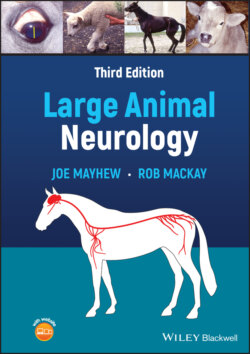Читать книгу Large Animal Neurology - Joe Mayhew - Страница 49
Rectum, bladder, anus, perineum, and tail
ОглавлениеTail tone can be assessed prior to testing the perineal reflex, and it is exceedingly variable between patients. A completely flaccid tail with no voluntary movement is indicative of a lesion of sacrocaudal spinal cord segments, nerves, or muscles. Decreased movement of the tail can be detected with lesions cranial to the caudal segments, but usually the spinal cord lesion must be severe for the weakness to be apparent. Some horses with no known neurologic lesion(s) hold their tail to one side, and others are considered natural tail wringers and flick their tails vertically and laterally while moving. A crooked tail carriage appears to be more prevalent in lame horses than non‐lame horses.39
Fixed torticollis of the caudal vertebrae, or wry tail (caudal vertebral scoliosis), should alert the examiner to the possibility of the presence of other spinal malformations, but it may, particularly in adult cattle, be due to overzealous twisting of the tail.
The perineal reflex is elicited by briskly prodding the skin of the perineum and anus while observing reflex contraction of the anal sphincter and clamping down of the tail. The sensory fibers are contained within the perineal branches of the pudendal nerve from S1–S3. Contraction of the anal sphincter is mediated by the caudal rectal branch of the pudendal nerve, and tail flexion is mediated by the sacral and caudal segments and nerves, S1–Ca. Light tactile rubbing of the anus will usually result in reflex tail extension that in adult cows at least can herald the onset of a micturition reflex. An animal with a flaccid tail and anus due to a final motor neuron lesion will not have an anal or tail reflex. However, it may still have normal sensation from the anus and tail provided that the sensory nerves and spinal cord and brainstem white matter nociceptive pathways are intact. Thus, as with all other reflex testing, the sensory perception of the stimulus must be evaluated separately from segmental reflex action.
The spinal cord ends at the level of the first or second sacral vertebra in large animals. Therefore, focal lesions of the last lumbar and of the sacral and caudal vertebrae may involve components of the cauda equina, hence the afferent and efferent spinal nerve roots from many sacrocaudal spinal cord segments. Depending on the level, this causes varying degrees of hypalgesia, hyporeflexia, hypotonia, and ultimately muscle atrophy of the tail, anus, perineum, hips, and caudal thighs. A rectal examination may detect a space‐occupying lesion or fracture or luxation of the lumbar, sacral, or caudal vertebrae. In addition, assessment should be made of urinary bladder volume and the tone of the bladder and rectal walls. Adult animals, especially male horses, that are recumbent for any reason, often do not urinate. Thus, they usually have a distended bladder that eventually results in urine dribbling. Manipulating such an animal to help it stand, or violent attempts by the animal itself to stand, can result in rupture of a bladder wall that is already weakened by pressure necrosis.
It is reasonable to interpret that an animal that is ambulatory and has nonobstructive distension of the urinary bladder with urinary incontinence probably has a lesion that affects the sacral spinal cord segments or the pelvic nerves or urinary detrusor muscle, a final motor neuron lesion bladder. In such cases, there will usually be excess feces in the rectum, but this usually will not cause overt constipation unless there is a dense, diffuse, sacral, final motor neuron lesion.
Paraplegic large patients frequently contuse the perineum and tail while dog‐sitting and while attempting to stand. Also, tail ropes and various forms of sling support frequently damage these areas. An assessment of the neurologic function must be made as soon as possible because perineal and tail contusion results in edema, quickly followed by hypotonia, hyporeflexia, and hypalgesia.
By this stage of the examination, the clinician should have a clear idea of the presence and location of lesions in the brain, spinal cord, and the peripheral nerves and muscles of the thoracic and pelvic limbs. The more peripheral the lesion, the better defined the sensory and motor deficits. Syndromes resulting from lesions involving specific limb peripheral nerves involve characteristic abnormalities of gait, paralysis of specific muscles with resulting muscle atrophy, specific reflex loss, and sensory deficits that are discussed further below.
